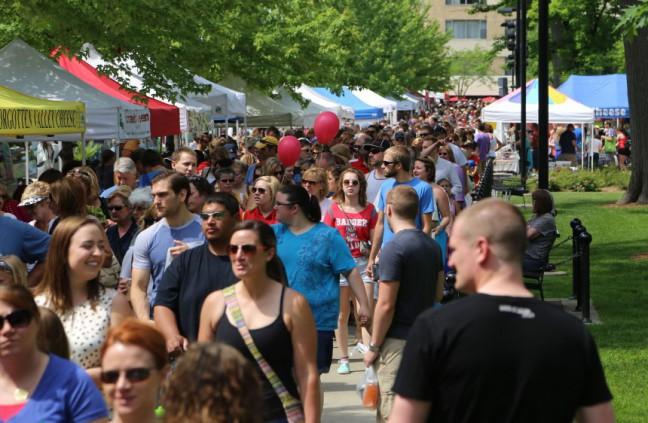Editor’s Note: In the original version, the outer ring was referred to as the DCFM. This is incorrect, and has been adjusted appropriately throughout.
The Dane County Farmers’ Market (DCFM) is ending its outdoor run in November. Saturday mornings will no longer start with food carts or Stella’s hot and spicy cheese bread. You won’t be able to buy fresh produce, fall flowers or potted herbs. However, as we lay hungover in our beds, reflecting on what we have purchased this summer, we must ask ourselves, what is this? Who runs it? Who decides whether to have seven apple stands or six? Finally, what are the political inner workings of our beloved DCFM?
First off, you may have noticed while walking clockwise around the Capitol, and attempting to avoid an endless parade of baby strollers, there are is one vendor ringer of the DCFM. It is the inner circle (the circle closes to the capitol), which sells things that must be grown by the vendor. If you sell honey, you must own bees. If you can salsa, you must grow tomatoes, chilies, onions, etc. If you are pushing pastry goods, you must have licensed kitchens. The outer circle (across the street) consists of vendors who produce their products; this can include food or arts and crafts. For instance, Ernie’s Kettle Korn does not grow corn. They do pop the kernels in a giant kettle right in front of you. Bare Tree Apparel does not sew the shirts he sells. He creates and prints the designs that are on the clothing items.
Because the inner ring is the DCFM, we can dissect that ring first. In the 1970s, when the DCFM first started, any vendor was allowed to sell their goods on the Capitol Square. They secured their spot by setting up their tent the night before and paid the fees in the morning. Today, however, the logistics are very different.
If you wish to become a vendor in Madison, you must acquire the appropriate permits and pay the mandated fees. First, you must purchase a general street vendor license, which is required for any individual who conducts sales on public property. The cost is $75 a month, with an additional annual $150 fee. The outer ring of vendors are different; they have city permits, and must purchase other permits depending on what they sell. The outer ring is actually representative of what could be called the “Madison public market,” a separate entity entirely from the DCFM, which may be surprising to some.
In regards to the DCFM, if you would like to sell food on the Capitol Square (or, for instance, Library Mall), you must pay an additional $850 fee. You also must obtain the appropriate health permits. If the product isn’t food, then it is a $450 annual fee plus $125 per month. Although the fees may seem shocking, the DCFM is the largest outdoor farmers’ market in the United States. Most people consider the fees as simply a necessary part of the process. And while it may be, there are things that go on just outside the DCFM, in the outer ring, that are rather questionable.
Every September, the vendors are judged to see if they can continue to sell there. Their product, presentation and originality are considered when making this decision. Several judges will taste what you sell and fill out answers for questions on a survey. The questions include: “Is the aroma enticing?” or “Can the food be carried away from the cart without dripping or spilling?” or “Is the use of color texture and materials imaginative in the apparatus?” The judges give vendors a score out of 100 and rank each vendor by score. The top 40 vendors are allowed to stay. The remaining vendors must make other plans. This part of the process seems to make the least amount of sense.
First, the evaluation survey that is used has not been changed for at least 15 years. In those 15 years, the market and products have changed vastly. The products are not as simple as comparing apples to apples. How do you compare Steep & Brew to El Burrito Loco? How about Peruvian food versus Bubble Doubles? Can these different types of food be compared with the same scale and descriptions? Second, how are these judges qualified to decide what is the best product? Are they professional “foodies”? Do they have experience judging food? Do they simply like Curt’s Kettle Corn (ranked No. 1 by the judges) better than any other stand on the outer square?
The system does not seem to be very efficient. If we are looking for variety, how come FIB’s Italian Beef and Grill has two stands? Banzo has two stands as well, rated 18 and 19 in the top 40. What about originality? The majority of the vendors on the outer square are carts. This isn’t a bad thing but how different can one cart really be from one another?
The dated politics happening just outside the DCFM within the city of Madison should not discourage people from participating. While they are city vendors, they add to the farmers market experience, an outdoor activity that encourages community and buying local! In general, no matter what ring the vendors are in, city and DCFM regulations leave much to consider. These are indeed things you should consider next year when you are buying rhubarb or picking up snacks. These vendors, inner or outer ring, fought to be there and can easily disappear the following season.
Mackenzie Krumme ([email protected]) is a junior majoring in international studies and intending to major in journalism.














